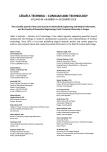THE ADOPTION OF AUTOMATED FiO2 CONTROL INTO POLISH NICUS: 2012–2019
Autoři:
Thomas Bachman 1; Maria Wilinska 2; Pawel Piwowarczyk 3; Michal Skrzypek 4
Vyšlo v časopise:
Lékař a technika - Clinician and Technology No. 4, 2019, 49, 119-124
Kategorie:
Original research
Souhrn
The introduction and adoption of new technology in medicine is a continuous ever present process but it is often not studied. Insights gained from documenting such experiences can not only guide local practices but also provide valuable quality benchmarks. Automated control of FiO2 based on continuous SpO2 (A-FiO2) not only reduces the challenging task of manual oxygen titration, but also has the potential to greatly improve the morbidity and mortality of extremely preterm infants. First approved for use in Europe in 2012, it is now available on most infant ventilators outside the USA. Poland was the first region in Europe to implement its clinical use. We report experience from 619 infants from 12 centers recorded in a web-based registry established in 2013 to document its use. We found the A-FiO2 was primarily used in the first week of life in intubated infants. However it is also successfully applied in both noninvasively supported infants and in those who were difficult to wean from oxygen and who exhibited frequent desaturations. We also found the SpO2 target range and alarm setting are not different from normal manual titration, although wider settings are also used and promise some benefit. Finally we report our plan to gather data from a national data base and detailed surveys. The surveys will document subjective aspects of this experience from a core group of centers. Details of the surveys are included and cover: experience with training and acceptance, changes in practice associated with the years of experience and barriers to broader use.
Zdroje
- Horbar JD, Badger GJ, Carpenter JH, et al. Trends in mortality and morbidity for very low birth weight infants, 1991–1999. Pediatrics. 2002; 110:143–51. DOI: 10.1542/peds.110.1.143
- Schwartz R, Luby A, Scanlon J, Kellogg R. Effect of surfactant on morbidity, mortality, and resource use in newborn infants weighing 500 to 1500 grams. N Engl J Med. 1994; 330:1476–80. DOI: 10.1056/NEJM199405263302102
- Swietlinski J, Bober K, Gajewska E, et al. Introduction of Infant Flow nasal continuous airway pressure as the standard of practice in Poland: the initial 2-year experience. Pediatr Crit Care Med. 2007; 8(2):109–14. DOI: 10.1097/01.PCC.0000257096.57260.3F
- Wilinska M, Bachman T, Swietlinski J, et al. Impact of the shift to neonatal noninvasive ventilation in Poland: a population study. Pediatr Crit Care Med. 2014; 15(2):155–61. DOI: 10.1097/PCC.0b013e3182a125f3
- Bachman TE, Marks NE, Rimensberger PC. Factors effecting adoption of new neonatal and pediatric respiratory technolo-gies. Intensive Care Med. 2008; 34:174–8. DOI: 10.1007/s00134-007-0914-6
- van Kaam AH, Hummler H, Wilinska M, et al. Automated versus manual oxygen control with different saturation targets and modes of respiratory support in preterm infants. J Pediatr. 2015; 167(3):545–50. DOI: 10.1016/j.jpeds.2015.06.012
- Wilinska M, Skrzypek M, Bachman T, et al. Using the auto-mated FiO2-SpO2 control in neonatal intensive care units in Poland: a preliminary report. Developmental Period Medicine. 2015; XIX,3(216):263–70.
- Wilinska M, Bachman T, Swielinski J, et al. Quicker response results in better SpO2 control – a comparison of 3 FiO2-titration strategies in ventilated preterm infants. Ann Agric Environ Med. 2015;22(4):708–12. DOI: 10.5604/12321966.1185781
- Warakomska M, Bachman TE, Wilinska M. Randomized evaluation of two SpO2 alarm strategies during automated FiO2 control in the NICU. BMC Pediatr. 2019; 19:142.
- Wilinska M, Bachman T, Swietlinski J, et al. Automated FiO2-SpO2 control system in neonates requiring respiratory support: a comparison of a standard to a narrow SpO2 control range. BMC Pediatr. 2014; 14:130. DOI: 10.1186/1471-2431-14-130
- Askie LM, Darlow BA, Finer N, et al. Association between oxygen saturation targeting and death or disability in extremely preterm infants in the Neonatal Oxygenation Prospective Meta-analysis Collaboration. JAMA. 2018; 319(21):2190–201. DOI: 10.1001/jama.2018.5725
- Mitra S, Singh B, El-Naggar W, McMillan DD. Automated versus manual control of inspired oxygen to target oxygen saturation in preterm infants: a systematic review and meta-analysis. J Perinatol. 2018; 38(4):351–60. DOI: 10.1038/s41372-017-0037-z
- van Zanten HA, Kuypers KL, Stenson BJ, et al. The effect of implementing an automated oxygen control on oxygen satu-ration in preterm infants. Arch Dis Child Fetal Neonatal Ed. 2017: 0:F1–5. DOI: 10.1136/archdischild-2016-312172
- Poets CF, Franz AR. Automated FiO2 control: nice to have, or an essential addition to neonatal intensive care? Arch Dis Child Fetal Neonatal Ed. 2017;102:F5–6. DOI: 10.1136/archdischild-2016-311647
- Maiwald CA, Niemarkt HJ, Poets CF et al. Effects of closed-loop automatic control of the inspiratory fraction of oxygen (FiO2-C) on outcome of extremely preterm infants – study protocol of a randomized controlled parallel group multicenter trial for safety and efficacy. BMC Pediatr. 2019; 19, 363. DOI: 10.1186/s12887-019-1735-9
Štítky
BiomedicínaČlánek vyšel v časopise
Lékař a technika

2019 Číslo 4
Nejčtenější v tomto čísle
- METHODS FOR KINEMATIC ANALYSIS OF HUMAN MOVEMENT IN MILITARY APPLICATIONS: A REVIEW OF CURRENT AND PROSPECTIVE METHODS
- THE EFFECT OF FRAME RATE AND CALIBRATION ON LUNG MONITORING WITH ELECTRICAL IMPEDANCE TOMOGRAPHY
- THE EFFECT OF SPEED ON GAIT ASYMMETRY IN SUBJECT WITH CONGENITAL TIBIAL DEFICIENCY: A CASE STUDY
- THE ADOPTION OF AUTOMATED FiO2 CONTROL INTO POLISH NICUS: 2012–2019
